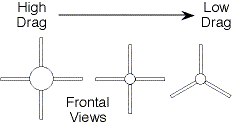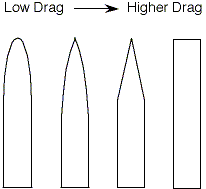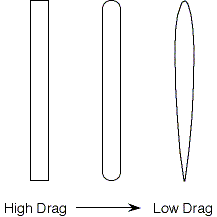Our Tel: 719-535-9335 Apogee Components, Inc. 1130 Elkton Drive, Ste A Colorado Springs, CO 80907 USA | ||||||||||||||||
|
Technical Publication #1 If two engines made by different manufacturers have the same total power (called total impulse) shouldn't they both launch similar rockets to the same altitude? The answer to this question is Yes and No. It depends on where you launch the rocket. A model rocket is affected by three forces during its flight. These are the thrust of the rocket motor, the force of gravity trying to pull the model back down to the ground, and air resistance which is called drag. So there are two forces trying to hold the rocket down, while one force - thrust - must overcome these two other forces in order for the model to take to the air. It would seem logical that if the total thrust is the same for two different rocket engines that the models should travel to the same altitude (with all other things being equal). But the reason one rocket may travel higher is because differences in the drag force. Aerodynamic drag or simply, drag, is the resistance or friction force experienced by any object moving through air. All rockets have a drag force and, although it cannot be eliminated, it can be reduced. Knowing what conditions or factors cause an increase in drag allow us to make rocket designs that will minimize this undesirable force so that the rocket can travel higher. Factors that affect the total drag force on a model are: the density of air, the frontal area of the model exposed to the oncoming air, a unitless factor called the coefficient of drag, and the velocity of the model. Mathematically the drag force experienced by a rocket can be expressed by the following equation:
where: D="Drag" force on the rocket We should look at each of these factors to find out how we can make our rockets fly higher, and find out why Apogee model rocket motors push our rockets to higher altitudes. Frontal Area The frontal area is the area you would see if you were looking directly down on a rocket as it was sitting in a vertical position. From the drag equation, it can be seen that if this area were decreased, the drag of the model would be decreased.
It stands to reason that a smaller diameter rocket should fly higher than one with a larger diameter. This reason alone should allow Apogee rocket motors to fly higher. Apogee model rocket motors have a smaller diameter than other rocket engines, so they can be used in rockets with smaller diameter tubes. But this is only one reason why Apogee rocket motors push models higher into the air. What happens when the diameters of the two rockets being compared are equal? You'll have to read on to find another reason Apogee rocket motors still have a better chance of pushing your rockets higher into the air. Density of Air The number of air molecules per unit volume is what is termed as density. In the drag formula, it can be seen that as the density increases, the total drag force increases. Likewise, when the density of the air is reduced, the drag force decreases. Can the density of air be controlled by the modeler? Unfortunately, no. The only way you can decrease the density of air is to launch from the top of a tall mountain, or on a hot day (with low humidity). But, look what happens when the density of air is zero - the total drag force is also zero, so the rocket thrust is only fighting against the force of gravity. Where can you find nearly zero air density? In outer space! Where there is no air, you have no air density. If you could perform your comparison test of two rockets from the surface of the moon, then they would both fly to the same altitude if the rocket motors had the same total impulse. Since we usually launch our rockets from the surface of the earth, we'll always be dealing with air density, so we'll always have a drag force working against us. Drag Coefficient The drag coefficient takes into account the shape of the rocket. It is a unitless number, so it may be hard to understand. This number is a combination of several factors, which are: form drag, induced drag, and skin friction drag. Form drag is due to the shape of the rocket. For example, a rounded shape has less drag than a blunt shape, because the air flows over the surface easier. This is the reason why airplanes and rockets have rounded noses. The act of making the air flow easier over a rocket is called streamlining. This is why fins should be sanded into a streamlined or teardrop shape; making them round at the leading edge, and tapering them to a sharp edge at the trailing edge.
Skin friction drag is caused by the air particles in the airstream being slowed down by the microscopic bumps on the surface of the rocket. This TYPE of drag can be reduced by making the surface of the model as slick and smooth as possible. Induced drag is produced by the fins and wings of a rocket or airplane. Whenever a lift force is produced, induced drag is also produced. It is a result of air flowing around the tip edge of the wing or fin from the high pressure side to the low pressure side. Making the air change direction to flow around the corner takes energy, and this energy must come from somewhere. The place where it comes from is the speed of the rocket - the model must slow down by some small amount. This is drag. On rockets, the induced drag can be reduced by proper fin shape. The drawing shows a few fin shapes that have low induced drag. Induced drag can be eliminated completely if you have no lift. If the rocket flies completely vertical and doesn't wobble during flight, there should be no need for the fins to produce a restoring force (lift) to correct the trajectory of the rocket. Therefore to make the rocket fly high, keep it stable during its flight.
Since we are comparing similar rockets, we are assuming that the drag coefficients are identical. So we can ignore this term for our comparison of different rocket motors. Velocity of the Rocket We have finally got to the factor that allows us to see why a rocket using an Apogee model rocket motor will fly higher than one made by other manufacturers. Many novices think that if you fly very fast, you must be able to fly higher. But this is not true if you are flying through air. From the drag equation, you can see the detrimental effect of having a rocket fly fast - it has more drag. Not only does it have more drag, but one rocket traveling twice as fast as another doesn't have twice as much drag, it has four times the drag force. This is because the velocity term in the equation is squared. The faster you fly, the more drag you must overcome. So to fly higher, you want to fly slower. The velocity of the rocket is controlled by the rocket engine. A high thrust rocket motor will make the rocket travel at a higher speed. A low thrust rocket motor will keep the speed of the model down, therefore keeping the drag lower so the rocket can travel higher. How can you determine the level of thrust of the rocket motor? The simplest way is to read the code printed on the rocket motor case. The first number (after the letter) tells the average thrust force of the rocket in Newtons. The smaller this number, the lower the thrust force. Apogee model rocket motors are designed to keep the drag on a rocket low, so that the model can fly higher into the air. They use the same safe propellants used in model rocketry for the past 35 years, but they burn the propellant in a different way. They burn the propellant slower, for a longer period of time. This keeps the total impulse of the motor the same as others, but allows the model have travel higher into the air. Can you use Apogee model rocket motors in kits from other manufacturers? Yes! All that you need to use Apogee model rocket motors in other manufacturer's kits is an adapter to allow the small diameter motors to fit into large diameter tubes. Apogee has such an adapter available that you can order so you can use the high performance rocket motors in your current models. Just call or write Apogee Components and order Adapter Kit (#3102). It can be used in most any kit that has an 18 mm motor mount. There is one very important factor you must consider when selecting any rocket motor for your model. That is the lift-off weight of the rocket. Since Apogee rocket motors allow the rocket to fly at slower speeds, it is possible to fly too slow. Heavy rockets need higher thrust levels to reach sufficient speeds where the fins become effective at controlling the stability of the rocket. If your model doesn't reach this critical speed, it will become unstable, which is a very dangerous condition. So always make sure your rocket's weight is below the maximum lift-off weight for the rocket motor you are using. These lift-off weights are printed on the instructions that come with the rocket motors. You now know why Apogee model rocket motors make your rocket fly higher than those made by other manufacturers. If you combine a Apogee rocket motor in a small diameter rocket, the altitudes can be immense. We believe that every U.S. altitude record (as verified by the National Association of Rocketry) will be smashed using an Apogee model rocket motor. We hope that you will be the one to set the new record!
| ||



